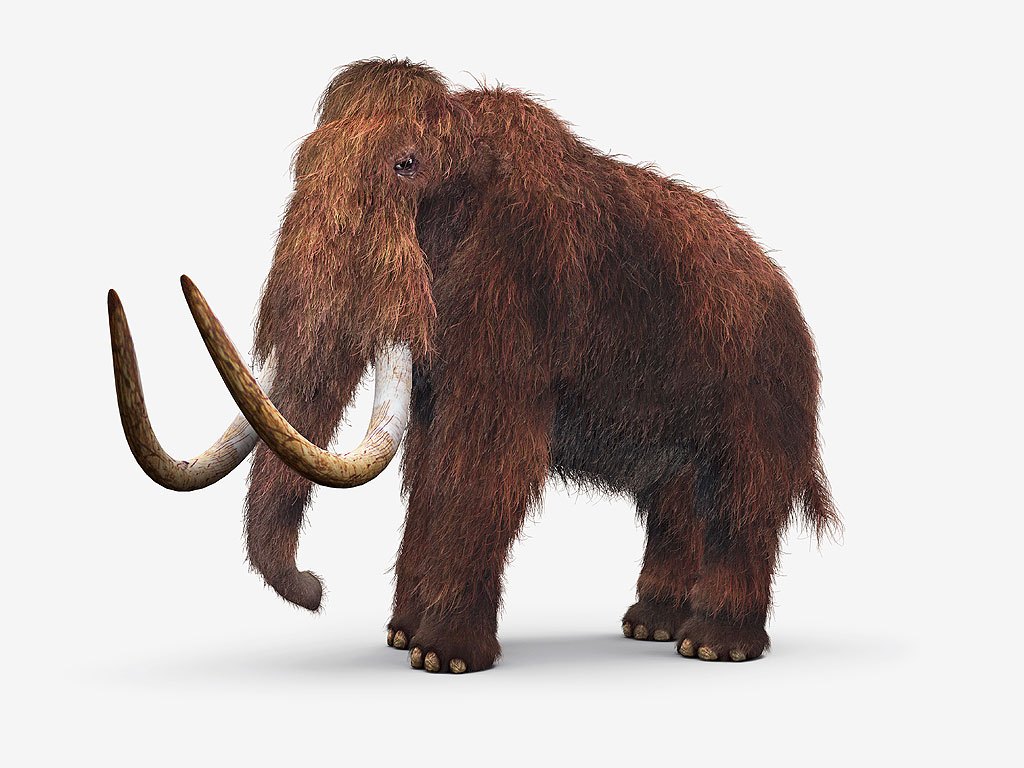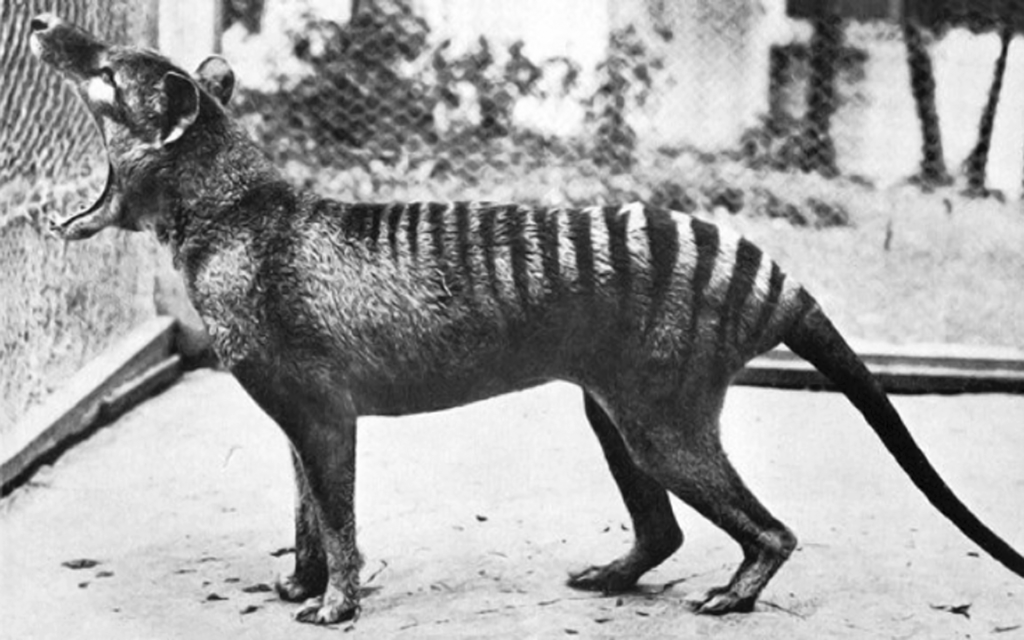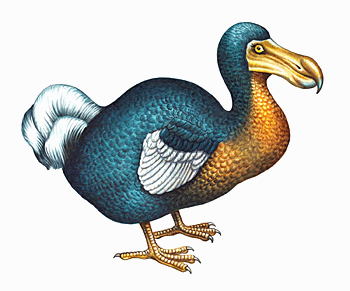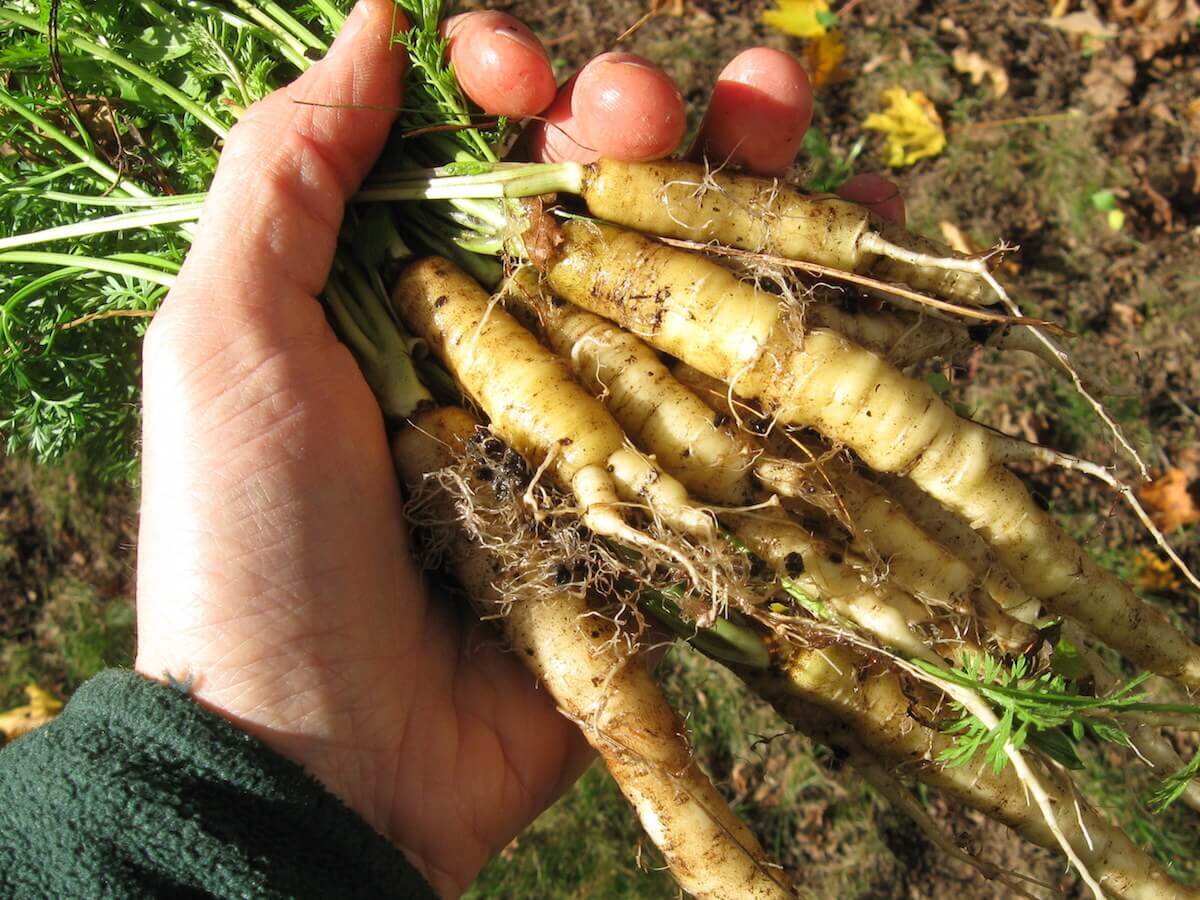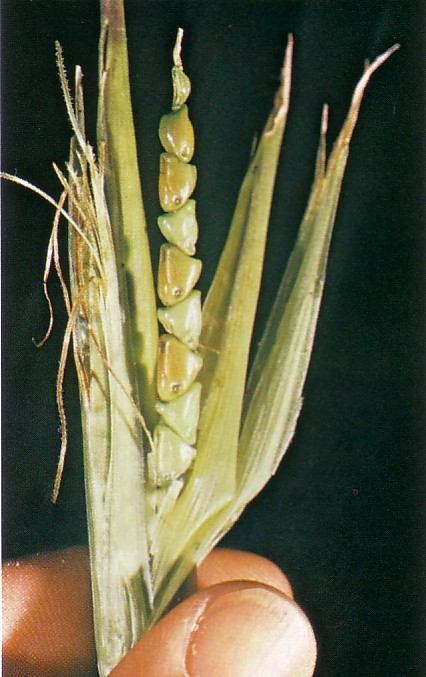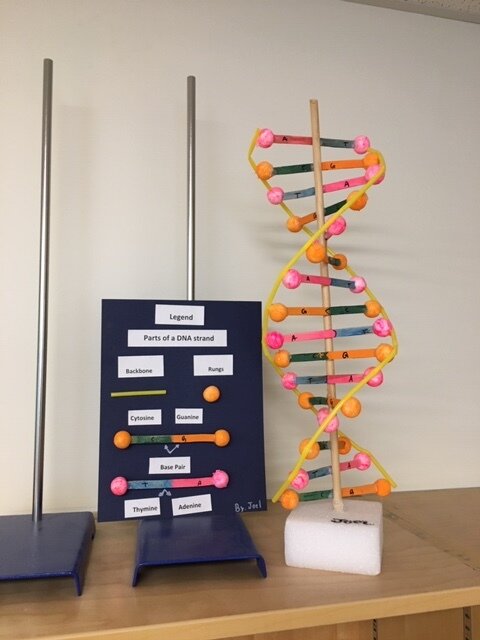DNA is the inherited material responsible for variation
DNA – Transmitter of Genetic Code
DEOXYRIBONUCLEIC ACID (DNA) :
Genetic material found mainly in the nuclei of cells of living things
Imagine all living things having a “book” inside their cells. This book is written in DNA.
This DNA book includes a complete set of instructions on how to build, maintain, and reproduce all living things.
The initial DNA “book” is inherited by offspring from the parents, and is responsible for variation amongst all living things.
How Large is this DNA Book?
The length of this book depends on the organism.
In humans this book has 3.2 billion letters! That’s a long book!
To put it in perspective here are some other books:
Average novel: 200,000 letters
Bible: 3,120,000 letters
Harry Potter series (7 books): over 4,000,000 letters
Human Genome: 3,200,000,000 letters
If you were to go into the nucleus of a human cell, and take out the DNA it would stretch out to be about 2m long which is more than 1 million times longer than the cell itself!
DNA History
DNA was 1st discovered in 1869 but little was known about its role
1944 – Canadian scientist Oswald Avery confirmed DNA was the material of inheritance.
James Watson and Francis Crick unraveled the structure of DNA and showed how the same chemical building blocks could carry out a wide range of instructions
How does DNA look?
DNA looks like a ladder spun around in a continuous spiral, the side of the DNA is dubbed the phosphate back-bone, while each ‘rung’ is composed of two nitrogen bases.
Nitrogen Base:
A chemical compound made of nitrogen that forms a part of DNA, nitrogen bases pair up to form nitrogen pairs:
guanine
cytosine
adenine
thymine
Think G-CAT , guanine and cytosine are always paired together as are adenine and thymine
GENome :
The arrangement and order of nitrogen bases forms the ‘letters’ of the DNA molecule that can be arranged into ‘words’ that form instructions for making an organism. These instructions are known as a genome.
The arrangement of these 4 chemical forms a code the cells can read (like the alphabet where the letters can be arranged into millions of different words)
Chromosomes
HUMAN KARYOTYPE - SCIENTISTS USE FLORESCENT MARKERS ON HUMAN CHROMOSOMES TO CREATE A FALSE COLOR IMAGE
CHROMOSOMES:
Organisms arrange the DNA into packages whose contents are neatly put together into structures that easily fit into the cell.
DNA is like a book and chromosomes are the chapters
Chromosomes are inherited in pairs, humans cells have 46 chromosomes in total, 23 from mom, 23 from dad.
When corresponding chromosomes hang out together (usually before cell division aka meiosis) it is called a homologous pair.
Every cell in the human body has 46 chromosomes, except the gametes which have a single set of chromosomes which is 23
Dogs have 78 chromosomes (homologous 39 pairs), cats have 38 chromosomes (homologous 19 pairs)
Genes
Genes:
An uninterrupted segment of DNA which contains coded instructions responsible for the inheritance of an organism’s characteristic features.
Genes are inherited in pairs (because chromosomes are in pairs!)
Both genes in a pair carry DNA instructions for the same thing
Same gene occupy matching locations but may not be exactly the same in both locations
ALLELES :
Possible 'forms' of a gene. (think of genes like light switches, and alleles as either on or off)
For example: The alleles for eye colour would include brown eyes, blue eyes, green eyes, hazel eyes, etc.
Are genes and characteristics that simple?
Is there are gene for every characteristic of living things, well it’s a bit more complex.
For example:
A “hairy coat” in dogs varies. A dog could have straight, curly, short, long, coarse, fine, and colour that are all different possibilities for “hairy coats”
However the “hairy coat” characteristic is a combination of several characteristics.
More than one gene pair may be involved in determining the individual characteristics of a dog’s hairy coat
There could be several alleles for each gene pair
Combining many genes and many allele options would produce a mixture of characteristics that could be endless!
CRISPR, the gene editing tool!
Cell Division
Single cell division - Asexual Reproduction
When single cell organisms like bacteria divide we call it binary fission
For binary fission, the unicellular organism (ex. Paramecium) makes an exact copy of its DNA – each chromosome doubles
Then the cell divides, each new cell has a complete set of DNA
MITOSIS - DO YOU KNOW HOW CRAZY IT IS TO SEE THIS?
Multicellular organism cell division
MITOSIS :
Type of cell division that produces two identical daughter cells from one parent cell.
Responsible for growth and cellular repair of a multicellular organism.
This process produces 2 new cells with the same number of chromosomes.
THIS CELL STARTS OFF WITH 2 CHROMOSOMES, AND AFTER DIVISION HAS TWO CELLS WITH 2 CHROMOSOMES EACH.
All cells in the body that are not sex cells (gametes) divide this way. Skin cells, liver cells, bone cells, etc.
Cell Division - Sexual Reproduction in Plants and Animals
For sexual reproduction two gametes unite to form a zygote → male provides male gamete (23 chromosomes for humans) and female provides female gamete (23 chromosomes for humans) for a total of 46 chromosomes in humans.
Note: If the gametes had the same number of chromosomes as every other cell in the body, (ex. 46 in humans) then the zygote formed from sexual reproduction would have twice the DNA (92 chromosomes) it needs, not good!
In order to form gametes we need to divide the cell so that it only has half the amount of chromosomes. Hence meiosis!
MEIOSIS :
Type of cell division that produces cells with only ½ the DNA of a normal cell.
Meiosis involves two cell divisions (not one but two!)
Parent cell replicates chromosomes (2n)
Chromosome pairs crossover, DNA mixes up
Mixed pairs of chromosomes split into two cells (2n)
Then chromosomes split into another two cells (1n)
CELL STARTS OFF WITH 2 CHROMOSOMES, REPLICATES CHROMOSOMES, CHROMOSOMES CROSS OVER AND SPLIT INTO 2 CELLS, THEN SPLIT AGAIN INTO ANOTHER 2 CELLS, RESULTING IN 4 CELLS WITH 1 CHROMOSOME EACH
A very strange yet on point DNA cell animation
Patterns of Inheritance
TRAIT :
A characteristic of an organism
PUREBREED :
Referring to a plant or animal whose ancestors all carry the same form of a trait (ex. a cat with white fur whose ancestors have the trait for white fur only)
HYBRID :
An organism produced by crossing two purebred individuals for different forms of a trait (ex. black fur cat x white fur cat)
Dominant VS. Recessive
DOMINANT TRAIT :
The outward form observed when two opposite acting alleles are inherited
RECESSIVE TRAIT :
Out ward form observed when two same acting, non-dominant alleles are inherited
If we take hybrid black offspring and cross breed…
3 offspring are black and 1 is white (75% black, 25% white)
THIS IS CALLED A PUNNETT SQUARE
Possibilities:
(i) Black from mother (B) and Black from father (B) = Black (BB) offspring (2 dominant alleles)
(ii) Black from mother (B) and white from the father (b) = Black (Bb) offspring (1 dominant and one recessive allele)
(iii) White from mother (b) and black from the father (B) = Black (Bb) offspring (1 dominant and one recessive allele)
(iv) White from mother (b) and white from father (b) = White (bb) offspring (2 recessive alleles)
INCOMPLETE DOMINANCE :
The pattern of inheritance seen when 2 different alleles are present at the same gene location , but neither is dominant (ex. Red snap dragons and white snap dragons produce pink snap dragons)
A child with wavy hair as a result of one parent's curly hair and the other's straight hair.
If a red tulip and a white tulip are cross pollinated they result is a pink tulip
For eye colour, hair colour, and skin pigment it is much more complex than simply dominant and recessive or incomplete dominance
Some DNA Lingo
Genotype:
The set of alleles that an organism carries
For example:
BB
Bb
bb
phenotype:
The physical appearance of an organism which are determined by the alleles present
For example:
Brown eyes - BB or Bb (Both have the same Phenotype (brown eyes) but both have a different genotype)
Blue eyes - bb
Environmental Factors can also affect DNA
Here are just a handful of different ways DNA can be affected by the environment:
FAS – Fetal Alcohol Syndrome or
Thalidomide given to pregnant women produced offspring with abnormally developed limbs
High energy radiation can cut up DNA
Epi-genetics
Reduction of Biological Diversity
Species and ecosystems and their processes are being stressed by urbanization, agriculture, and forestry
EXTINCTION :
Disappearance of every individual of a species from the entire planet
Scientists estimate that 99% of all species that have ever existed are now extinct
Can happen by catastrophic events or over a long period of time
EXTIRPATION :
A local extinction or disappearance of a species from a particular area (ex. Grizzly bear on the prairies)
Natural Causes of Extinction and Extirpation
Natural Causes of Extinction
Catastrophic events (volcanic eruptions, floods, fire, etc.)
Lack of food due to over population
Disease
OVER SPECIALIZATION :
Species has adaptations for a small set of environmental conditions, which leaves it vulnerable to extinction (Ex. Giant Panda eats only bamboo that is disappearing)
Human Causes of Extinction and Extirpation
Humans manage to disturb ecosystems in four major ways:
Habitat destruction - loss of habitat due to construction, agriculture, development, logging, damming of rivers
Pollution – Introducing pesticides, herbicides, and fertilizers that can damage environments and cause birth defects
Over-hunting/Over-fishing - Hunting of plains bison, prairie dogs, beavers, foxes. Over fishing of tuna, salmon, and whales
Introduction of non-native species (Bio-invasive species)
Ex. Horses & cattle brought by European settlers – compete with native species for resources
Bottom line is that extinction and extirpation reduce biological diversity
Selecting Desirable Traits
ARTIFICIAL SELECTION (Selective Breeding):
Breeding by humans of plants and animals with desirable traits to produce offspring with those desirable traits (ex. Horse and dog breeding)
The basics to selectively breed organisms:
Farmer Sarah wants more corn yield out of a corn plant, so she take 100 corn plants and finds the top 20 corn plants which yield the highest amount of corn
Sarah will now take those top 20 corn plants and cross breed them together creating 100 new corn plants
Sarah will grow those 100 new corn plants, she will again choose the top 20 corn plants that yield the most and again cross breed them to yield another 100 corn plants
Sarah will continue to this process for generations until she is satisfied with how much each corn plant yields. This process takes years and years!
Selective breeding can be used in food to “weed out” undesirable traits (Ex. corn that is susceptible to fungus)
Selective breeding can be used to increase a desirable trait (Ex. cows with higher milk production)
Many of our plants no longer resemble wild species due to artificial selection for over 10000 years
Ethics of Artificial Selection
Make a pros and cons list :
In groups of 3 brainstorm the consequences of artificial selection (ex. increases yield of banana’s)
Create a T- Table with pros on one side and cons on the other
From the list of consequences brainstormed determine if they are a pro or con
BIOTECHNOLOGY used in artificial selection
Humans have used artificial selection for ages!
The use of living things to make agriculture, industrial or medical products
Takes many generations to get a full crop/herd with desired traits
Can be “high tech” or “low tech”
CLONES :
A genetically identical copy of an entire organism or its cells or genes; cloning is the process of creating a clone (ex. Cuttings of plants)
Cells are now removed from plant with desired traits and placed in a Petri dish with nutrients and hormones they need. They then develop into seedlings
ARTIFICIAL INSEMINATION :
Artificial collection and injection of sperm from a male into a female; used in livestock breeding (ex. Bull sperm inserted into many cows)
INVITRO FERTILIZATION :
Fertilization that happens outside the body, usually in a Petri dish; used in livestock breeding (ex. Prize cow eggs with bull sperm and embryos are implanted into other cows)
GENETIC ENGINEERING:
The intentional altering of DNA of an organism or population of organisms (ex. Inserting a gene from one species into another species – human insulin producing gene into bacteria)
- All of these technologies, although beneficial to humans, can put species at risk of disease due to their similarities or resistance (ex. Weeds in crops to herbicides)
Reducing our Impact on Biological Diversity
1992 - United Nations Convention on Biological Diversity (Nations together build and execute an action plan)
1995 – Canadian Biodiversity Strategy
IN-SITU CONSERVATION:
The maintenance of wild organisms within their functioning ecosystem (Ex. National Parks)
Linking protected sites with corridors
Restoring land to natural states (ex. Wetlands) through private and corporate donations
Any species classified as endangered or threatened is protected by law from hunting, capture, picking, or transplanting
Species are assessed by the Committee On The Status Of Endangered Wildlife In Canada (COSEWIC)
Nationally – Species at Risk
Alberta – Endangered Species Conservation Committee (ESCC)
EX-SITU CONSERVATION :
The maintenance of organisms outside of their ecosystems or natural habitats; an endangered species populations maintained in a zoo for instance or seed banks for plants.














